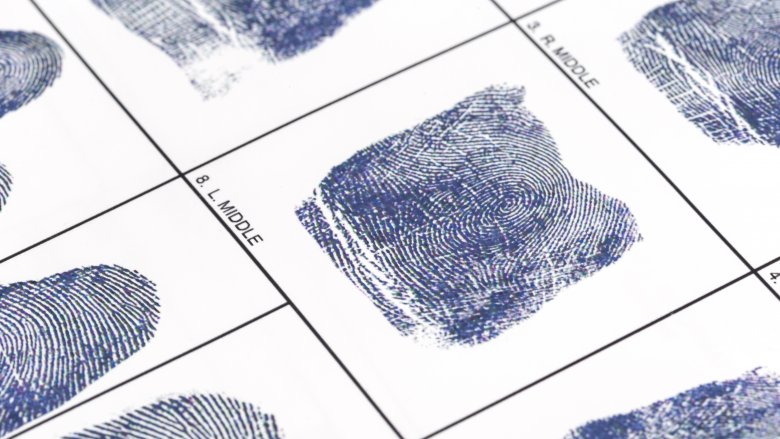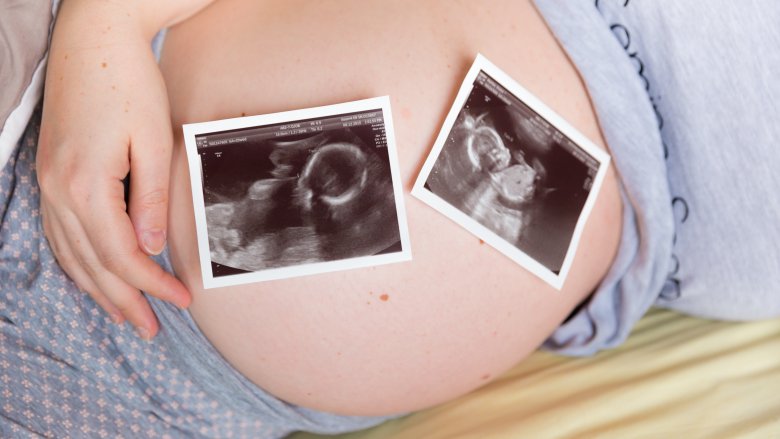Strange Facts You Never Knew About Twins
The whole concept of twins sounds like something out of a wacky science fiction story, probably one that also involves Tralfamadorians and/or money trees. Seriously, think about it: people with a genetic duplicate, formed at the same time, and even sharing the same DNA? Yeah, clones in the womb. Got it. C'mon, Vonnegut, you're stretching reality too far this time.
Everyone knows the basic story of the birds and the bees. Mr. Sperm swims around and meets Ms. Egg, then boom — fertilization! But twins are like the clever plot twist that no one ever saw coming. Ask any twin, and they'll tell you that having a natural clone is, well, pretty much the coolest thing ever. But being a twin is about more than just sharing secret handshakes and casually switching classes in high school.
Identical twins have different fingerprints
The term "identical twins" isn't just a funny party story about how your friend Chris looks a lot like Sylvester Stallone (but yes, that's very convincing). Identical twins are called "identical" because they pretty much are. Identical twins are nature's clones, and while they might not like sharing the same action figure, they can't help sharing the same DNA. However, as the New York Times points out, even if their faces look indistinguishable, and even if they wear matching T-shirts saying Thing #1 and Thing #2, identical twins have different fingerprints.
How could such blasphemy be possible? Well, because the whorls, loops, and funny shapes that we call fingerprints are "friction ridges" from the womb. These ridges are caused by a fetus touching the walls surrounding them. According to experts like Dr. Michael Roizen, the ridge shapes vary depending on the fetus's position, as well the density of the amniotic fluid spiraling around their fingers at different times. Identical twins occupy different parts of the amniotic sac, so their hands press against different places. Basically, the shape of a person's fingerprints is more customized as your favorite burrito at Chipotle.
Because of this, the Tech Museum of Innovation claims that checking fingerprints is about the only reliable way police investigators can determine which twin committed a crime. So yeah, sorry Jimmy. You can't blame your shoplifting on Timmy unless you wore gloves.
Identical and fraternal twins are totally different things
Grouping the "identical" and "fraternal" types into one "twin" category is like saying that key lime and apple are both "pies." It's time to decipher some twin-speak. Anyone who has twin-friends or twin-family has probably heard of the two variations before. What many may not realize is these two "types" of twins are created by entirely different situations within the woman's body.
First off, identical twins. Going back to the birds and the bees, when the sperm fertilizes the egg, it becomes a zygote, resulting in one baby. But every once in a blue moon, that single zygote splits into two embryos, which results in — that's right — identical twins. That's why identicals, aka monozygotic twins, have the same DNA: they were the exact same zygote at the beginning, until they shook hands, parted ways, and decided to be two people instead. Now there's an amicable settlement.
As far as fraternal twins go, the American Pregnancy Association says that's a whole other ballgame. Fraternal twins, aka dizygotic twins, happen when the mother has two eggs, and both of these eggs are fertilized by two separate sperm. Get it? Two eggs + two sperm = fraternal twins. So two fraternal twin sisters aren't "clones," and don't share any more DNA than regular siblings do. Instead, they're just sisters who rented out the same womb at the same time.
Sometimes, one twin vanishes in the night
Back before "ghosting" became a sketchy thing that people do on OKCupid, some twins were already masters at it. One of the eeriest things that can happen during a twin pregnancy is something called fetal resorption, or what experts like Professor Robert Wool call "vanishing twin syndrome." This describes a situation wherein a mother goes to an ultrasound, finds out she has twins, then returns later to discover that one of the twins has bamfed right out of existence, and she's now only going to have one baby. Ghosted!
So what happens to this poor vanished twin? Where do these teleportation powers come from? Thanks to X-Men comics, we now know. Vanished twins go on to become dangerous supervillains, like Charles Xavier's psychotic twin sister, Cassandra Nova. Watch your back, Charles.
The American Pregnancy Association offers the more plausible explanation that one twin dies during the early stages of the pregnancy, often from chromosomal abnormalities. Whatever fetal tissue remains is absorbed by the sibling, making it appear as if the dead twin vanished from thin air. It's estimated that this happens in 21 to 30 percent of multifetal pregnancies.
The living twin is usually perfectly healthy. So despite the bizarre conditions they were conceived in, these survivors possess no superpowers, no psychic personalities, and no big green Hulk-outs. However, in cases of vanishing fraternal twins, the survivors sometimes become chimeras, meaning one person with two sets of DNA. That's probably the closest we'll come to a superpower.
Twins that are separated at birth often lead bizarrely similar lives
The debate regarding nature vs. nurture will wage on for centuries, particularly once Skynet takes over and mankind tries really, really hard to pass the buck. General consensus is that both genetic and environmental factors play major roles in human development. But as far as twin psychology goes, the "nature" box should maybe be checked with a big fat Sharpie.
Twins who get separated at birth, totally unaware of each other's existence, often lead bizarrely parallel adult lives. What kind of shady, HYDRA-esque project would do something like separating twins? According to NPR, there was a secret research study done in the 1960s and 1970s. Even creepier, this study's results are locked in a vault until 2066. Yeah...
Anyway, one set of separated twins were Paula Bernstein and Elyse Schein, who finally reunited in their 30s. Aside from the obvious weirdness of meeting someone with the same face and voice, The Guardian describes their surprise at discovering that they were both writers with similar analytical personalities, political views, and quirky movie tastes. Both suffered from eating disorders as teenagers, edited their school newspapers, and studied film in college.
Then there are the "Jim Twins," according to Live Science, two separated twins who somehow both got named Jim. When they met as adults, they'd each been married twice — their first wives had been named Linda, and second wives named Betty. Weird, right? Both grew up in Ohio, were chain smokers, and drove similar cars.
Twins start socializing before they're even born
The womb is a lot like your first apartment out of school. It's cramped, messy, and you spend way too much time sucking strange drinks out of an even stranger tube. But that first apartment is all yours, and it's brand new to you, so you dig it. The only thing that could make it even better is a cool, friendly roommate, and that's exactly what twins have. Ask (almost) any twin, and they'll tell you: twins are tight. Many have an unbreakable bond. No joke, glue ain't got nothing on most twins. Recent evidence shows that twins actually start becoming BFFs all the way back when they're still rooming together in the womb.
That's right. According to Scientific American, twins get their social groove on while they're still just fetuses. By the 14th week of gestation, twins start reaching out to their new buddy. By Week 18, they're touching their partner more often than they're touching the walls or themselves, and with more deliberation, patience, and focus. They also take extra special care when touching their twin's eye region.
From this early stage of development, twins are already learning to bond, care about, and interact with a fellow human being. Though all the misanthropes out there might protest, humans are inherently social creatures, even on a purely genetic level, according to research published by the scientific journal Neuron. These buddy-buddy twin fetuses show just how hardwired those social instincts really are.
There are 'mirror twins' with reversed features
The phrase "mirror twin" holds enough scary possibilities to get any horror fan excited, but the reality is a lot more innocent. While mirror twins don't have the gnashing sharp teeth, 3-inch claws, or glowing red eyes that Stephen King might conjure up, they do have some rather weird differences from the everyday identical twin.
Basically, mirror twins look exactly alike except their features are reversed — a mirror image. They have 100 percent of the same genes, but these distinct aspects are flip-flopped. According to the Washington State Twin Registry, while one person may be right-handed, their mirror twin could be left-handed. One could have a unique little birthmark on their left leg, and the other would have the same birthmark on their right leg. Mirror twins could have an overbite on opposite sides. Despite this bizarre asymmetry, the twins are still monozygotic (identical).
Scientific American points out that sometimes, these mirrored traits get even weirder. For example, there have been cases where one person gets cancerous tumors on their left lung, only for their twin to develop tumors on the right lung. In any case, this whole freaky mirror twin business actually occurs in about 25 percent of identical twins, so it's not as rare as it sounds.
It's possible for conjoined twins to literally share a mind
Many twins swear they have ESP, though experts like Nancy L. Segal aren't convinced. Regardless, there's at least one set of conjoined twins who could make a pretty good argument. They aren't just physically connected at the head: they share thoughts and sensations, too.
Two young girls named Tatiana and Krista Hogan are conjoined twins whose skulls are merged together, rare craniopagus twins. The fact that they're alive is already miraculous, considering most twins born this way require a risky surgical separation for either to survive. However, what's really incredible about these two is that they seem to possess something never before seen in scientific history, according to the New York Times: a physical link between their two minds that allows them to literally experience sensations that occur to the other twin.
Between Tatiana and Krista's separate brains is a physical connection that their neurosurgeon calls a "thalamic bridge," which allows each girl to pick up on the sensory input that occurs to the other girl. For example, if one girl gulped down a slushy too fast, she could give the other girl a brain freeze. If one eats something, the other can taste it. They feel each other's pain. It's believed they can even perceive what the other is seeing out of their eyes, with a sort of parallel vision.
Though they have a unique condition, CBC Radio reports these two twins have enjoyed a normal childhood in a happy, loving home.
Fraternal twins can have two different fathers
It's hard to say whether this weird little fact would be more at home in a sci-fi novel or a screwball comedy, but it is what it is: Fraternal twins don't need to have the same dad. Yes, this really happens. If the timing, genetics, and environmental factors work out just right, fraternal twins could each have different fathers. Remember how fraternal twins result from a woman producing two eggs, and how each egg gets fertilized by different sperm? Well, let's say that she has intercourse with two different men during the same fertile time period, and both guys successfully fertilize their own egg. You know what happens next.
This phenomenon, which would probably make a killer rom-com starring Billy Crystal and Meg Ryan, is called heteropaternal superfecundation, according to BabyCenter. It occurs quite often with dogs, since female dogs commonly produce multiple eggs and have multiple partners. Humans usually only ovulate one egg at a time and are generally less promiscuous than our canine companions. But hey, it happens. As long as everybody involved is okay with it, right?
Before anyone thinks this is merely a theoretical notion based on canine breeding, hold up, because it does happen to humans. According to the Washington Post, one couple in Vietnam was worried that one of their baby twins might have been switched at birth, until tests revealed that the twins had different fathers. There's a DNA test someone probably wanted to take back.
Twins create their own languages
Sure, Duolingo is a great way to learn Spanish. And sure, it's cool that the new Star Trek has Klingon characters speaking in the actual Klingon language. But sorry, when it comes to languages, baby twins have everyone beat. Well before the adult world weighs these little sprites down with past participles and dangling modifiers, twins can make up their own languages.
This phenomenon, which the National Center for Biotechnology Information claims has been observed in 40 percent of twins, is called cryptophasia. While these young twins are still bouncing around in footie pajamas and listening to adults speak to them in squeaky voices, they're trying to communicate — but unlike most babies, twins get a partner, and the two of them will often put together a bizarre language that no one else understands. So yeah, almost half of twins spoke gibberish before they were toddlers, but that gibberish might have meant something.
These autonomous languages tend to fade away once the twins learn a "real" adult language, which is a shame because cryptophasic languages would make one heck of a Duolingo challenge. But not always. Matthew and Michael Youlden are two adult twins who took their childhood language, held onto it, and around age 7 began to actively develop it into a full language, complete with its own alphabet and grammatical rules. They call this language Umeri, and while it seems pretty awesome, they've largely kept it secret from the outside world.
The 'twin' gene runs in mothers, not fathers
Some families have all the luck. It really isn't fair. Twins already enjoy the pleasures of secret languages, fetal socialization, the best lifelong friend ever ... and then on top of that, doesn't it seem like twins often sprout twins of their own? It's like any twin you meet claims to come from a long line of twins. What's the deal? Did alien visitors plant the twin gene in one of their ancestors, and it's been growing in their bloodline ever since? The jury's still out on the aliens, but there is a twin gene. However, it only runs through women.
Hyperovulation — when a woman ovulates two eggs instead of just one — does seem to involve genetic factors, according to Scientific American. Most human women don't hyperovulate too often, and fraternal twins are only created by hyperovulation. So if you're a woman, and your mother or grandmother had fraternal twins, you stand a decent chance of popping out twins of your own. Get ready.
The twin gene is all about ovulation and is only carried forward by the mother, according to years of research cited by Johns Hopkins University. So if a male twin is really super-anxious to father his own twins, he'll need to find a woman who carries the twin gene herself. Or just leave it up to nature, because identicals seem to pop up out of nowhere sometimes.
They're multiplying!
Not surprisingly, these superpowered natural clones aren't waiting on the sidelines: They're taking over. As more twins pop up all over the globe, could anything but world domination be their next goal? Just imagine. Doors with two doorknobs, bunk beds everywhere, a spike in tandem bicycle sales. Clichés aside, it's true: There are more twins today than ever before. In 2014, a survey by the CDC showed the rate of twin births hit an all-time high, with over 33 of every 1,000 births producing twins in the U.S. Since 1980, the rate of twin births has jumped up 76 percent. See, they're taking over!
What factors led to the great twin uprising? First, contemporary women wait longer to bear children. Millennial women finish college before becoming mamas, and Dutch researchers found evidence that women in their 30s or older are more likely to have twins, due to hormonal shifts and higher chances of hyperovulation.
Another major factor? Science. The maniacal tinkerings of white-coated geniuses led to developments like in-vitro fertilization (IVF), which opened up pregnancy to millions of thankful couples who would've struggled otherwise. IVF involves eggs being extracted, combined with sperm in the lab, and then inserted back into the uterus. Voila, children! In order to ensure that the samples take, Newsweek describes how doctors will drop in more than one embryo. Multiple embryos kicking around increases the prospects of a successful baby. But guess what? More than one of those embryos might decide to stick around ... and then boom, twins!










